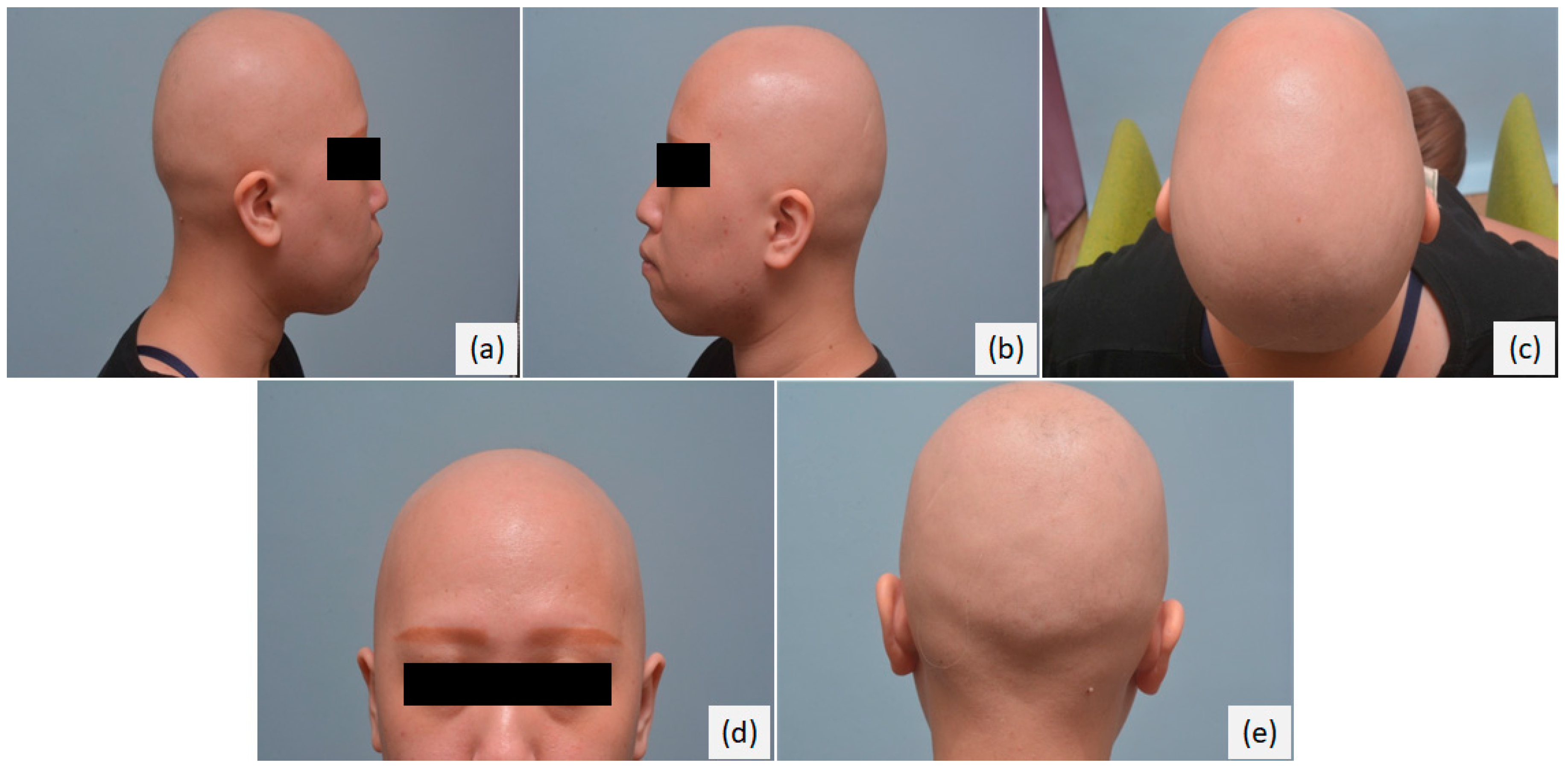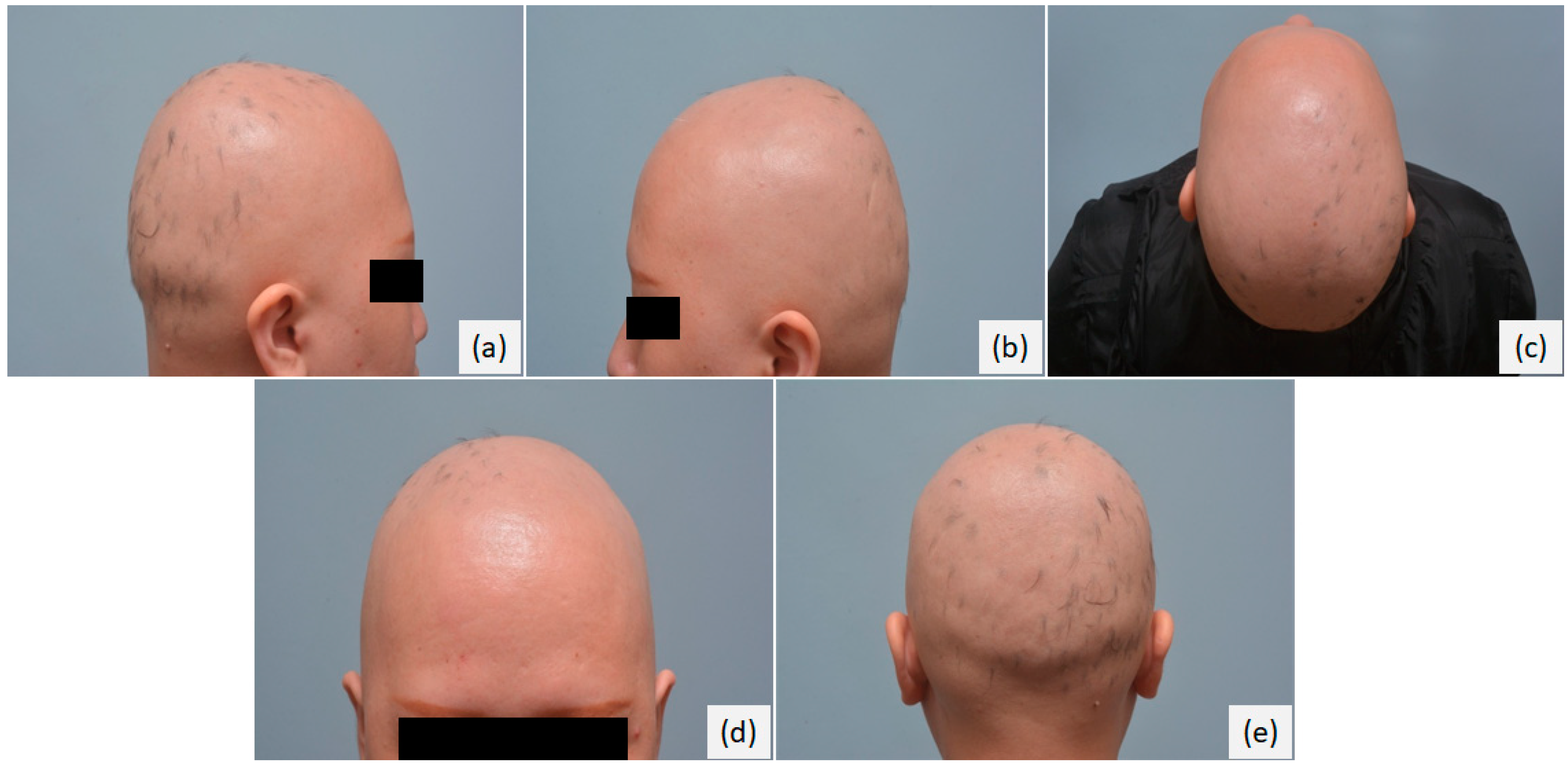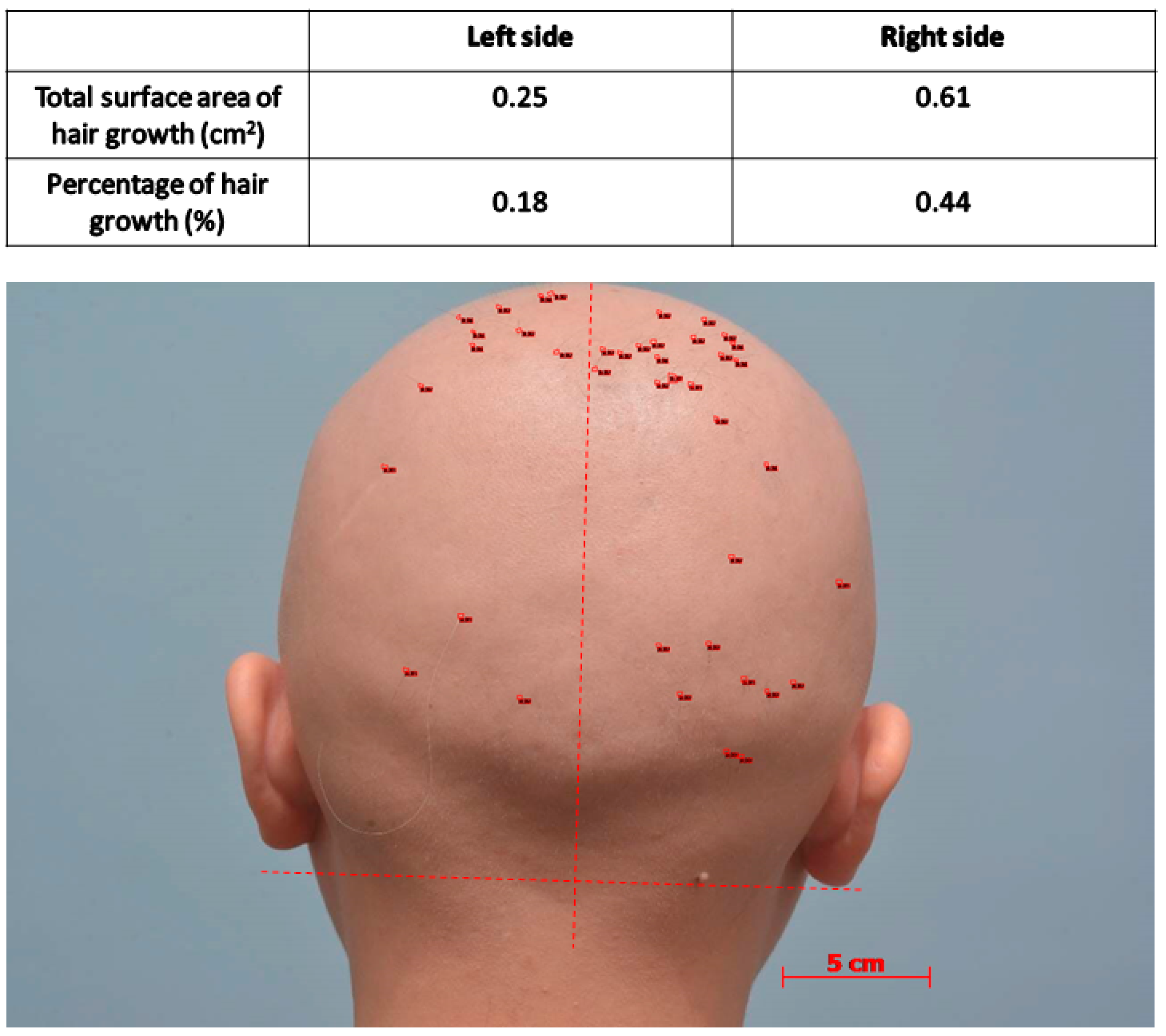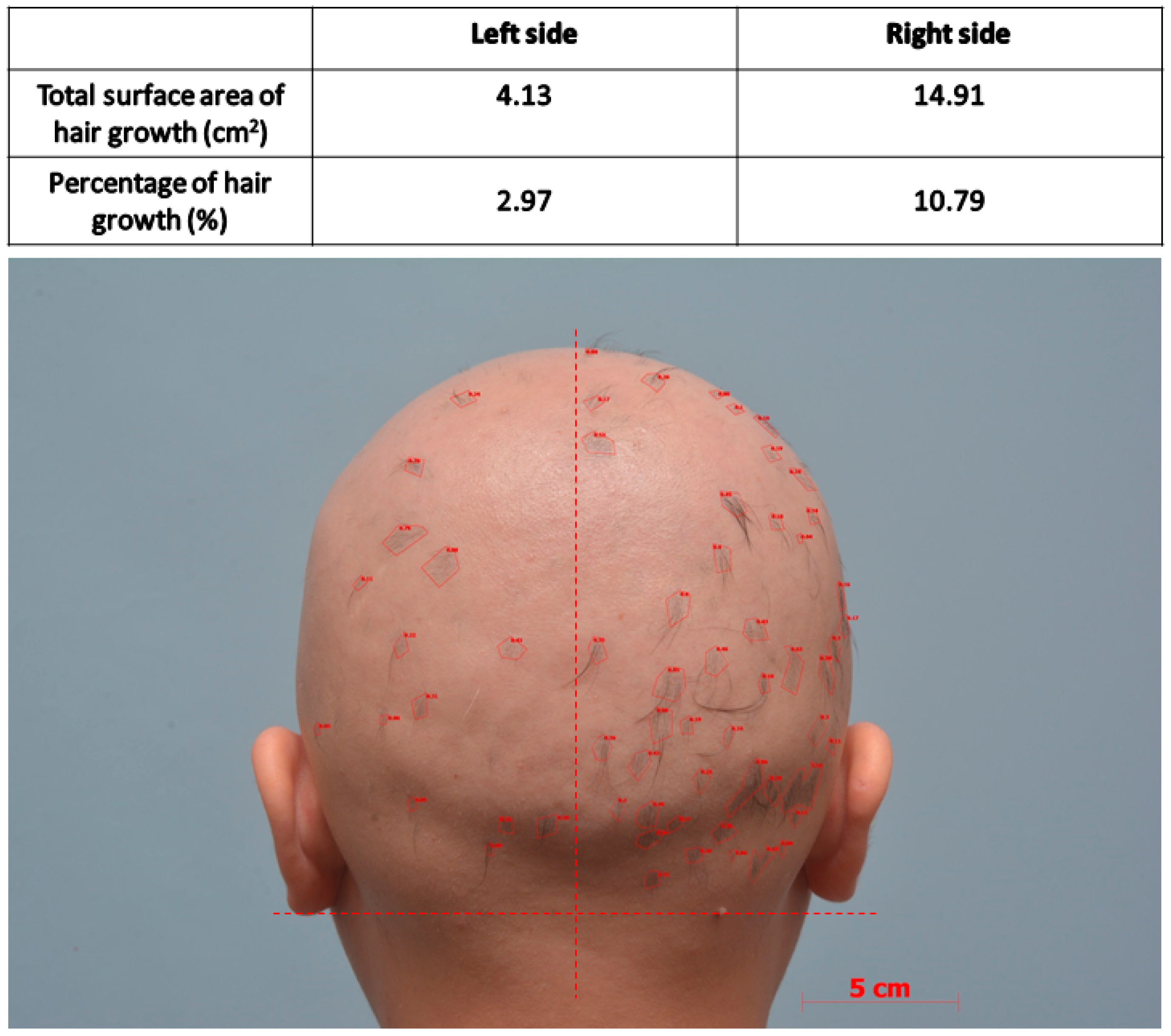Alopecia Totalis Treated with 1064 nm Picosecond Nd:YAG Laser: A Case Report
Abstract
1. Introduction
2. Materials and Methods
3. Results
4. Discussion
5. Conclusions
Author Contributions
Funding
Conflicts of Interest
References
- Pratt, C.H.; King, L.E., Jr.; Messenger, A.G.; Christiano, A.M.; Sundberg, J.P. Alopecia areata. Nat. Rev. Dis. Primers 2017, 3, 17011. [Google Scholar] [CrossRef] [PubMed]
- Mirzoyev, S.A.; Schrum, A.G.; Davis, M.D.P.; Torgerson, R.R. Lifetime incidence risk of alopecia areata estimated at 2.1% by Rochester Epidemiology Project, 1990–2009. J. Investig. Dermatol. 2014, 134, 1141–1142. [Google Scholar] [CrossRef] [PubMed]
- Hordinsky, M.K. Overview of alopecia areata. J. Investig. Dermatol. Symp. Proc. 2013, 16, S13–S15. [Google Scholar] [CrossRef] [PubMed]
- Mlacker, S.; Aldahan, A.S.; Simmons, B.J.; Shah, V.; McNamara, C.A.; Samarkandy, S.; Nouri, K. A review on laser and light-based therapies for alopecia areata. J. Cosmet. Laser Ther. 2017, 19, 93–99. [Google Scholar] [CrossRef]
- MacDonald Hull, S.P.; Wood, M.L.; Hutchinson, P.E.; Sladden, M.; Messenger, A.G.; British Association of Dermatologists. Guidelines for the management of alopecia areata. Br. J. Dermatol. 2003, 149, 692–699. [Google Scholar] [CrossRef]
- Charuwichitratana, S.; Wattanakrai, P.; Tanrattanakorn, S. Randomized double-blind placebo-controlled trial in the treatment of alopecia areata with 0.25% desoximetasone cream. Arch. Dermatol. 2000, 136, 1276–1277. [Google Scholar] [CrossRef]
- Kubeyinje, E.P. Intralesional triamcinolone acetonide in alopecia areata amongst 62 Saudi Arabs. East Afr. Med. J. 1994, 71, 674–675. [Google Scholar]
- Gupta, A.K.; Carviel, J.; Abramovits, W. Treating Alopecia Areata: Current Practices Versus New Directions. Am. J. Clin. Dermatol. 2017, 18, 67–75. [Google Scholar] [CrossRef]
- Darwin, E.; Arora, H.; Hirt, P.A.; Wikramanayake, T.C.; Jimenez, J.J. A review of monochromatic light devices for the treatment of alopecia areata. Lasers Med. Sci. 2018, 33, 435–444. [Google Scholar] [CrossRef]
- Jahn-Bassler, K.; Bauer, W.M.; Karlhofer, F.; Vossen, M.G.; Stingl, G. Sequential high- and low-dose systemic corticosteroid therapy for severe childhood alopecia areata. J. Dtsch. Dermatol. Ges. 2017, 15, 42–47. [Google Scholar] [CrossRef]
- Seiter, S.; Ugurel, S.; Tilgen, W.; Reinhold, U. High-dose pulse corticosteroid therapy in the treatment of severe alopecia areata. Dermatology 2001, 202, 230–234. [Google Scholar] [CrossRef] [PubMed]
- Friedli, A.; Labarthe, M.P.; Engelhardt, E.; Feldmann, R.; Salomon, D.; Saurat, J.H. Pulse methylprednisolone therapy for severe alopecia areata: An open prospective study of 45 patients. J. Am. Acad. Dermatol. 1998, 39, 597–602. [Google Scholar] [CrossRef]
- Senila, S.C.; Danescu, S.A.; Ungureanu, L.; Candrea, E.; Cosgarea, R.M. Intravenous methylprednisolone pulse therapy in severe alopecia areata. Indian J. Dermatol. Venereol. Leprol. 2015, 81, 95. [Google Scholar]
- Wiseman, M.C.; Shapiro, J.; MacDonald, N.; Lui, H. Predictive model for immunotherapy of alopecia areata with diphencyprone. Arch. Dermatol. 2001, 137, 1063–1068. [Google Scholar]
- Strazzulla, L.C.; Wang, E.H.C.; Avila, L.; Lo Sicco, K.; Brinster, N.; Christiano, A.M.; Shapiro, J. Alopecia areata: An appraisal of new treatment approaches and overview of current therapies. J. Am. Acad. Dermatol. 2018, 78, 15–24. [Google Scholar] [CrossRef]
- Phan, K.; Sebaratnam, D.F. JAK inhibitors for alopecia areata: A systematic review and meta-analysis. J. Eur. Acad. Dermatol. Venereol. 2019. [Google Scholar] [CrossRef]
- Kaur, S.; Mahajan, B.B.; Mahajan, R. Comparative Evaluation of Intralesional Triamcinolone Acetonide Injection, Narrow Band Ultraviolet B, and their Combination in Alopecia Areata. Int. J. Trichol. 2015, 7, 148–155. [Google Scholar] [CrossRef] [PubMed]
- Bayramgurler, D.; Demirsoy, E.O.; Akturk, A.S.; Kiran, R. Narrowband ultraviolet B phototherapy for alopecia areata. Photodermatol. Photoimmunol. Photomed. 2011, 27, 325–327. [Google Scholar] [CrossRef] [PubMed]
- Mohamed, Z.; Bhouri, A.; Jallouli, A.; Fazaa, B.; Kamoun, M.R.; Mokhtar, I. Alopecia areata treatment with a phototoxic dose of UVA and topical 8-methoxypsoralen. J. Eur Acad. Dermatol. Venereol. 2005, 19, 552–555. [Google Scholar] [CrossRef]
- Kamel, M.M.; Salem, S.A.; Attia, H.H. Successful treatment of resistant alopecia areata with a phototoxic dose of ultraviolet A after topical 8-methoxypsoralen application. Photodermatol. Photoimmunol. Photomed. 2011, 27, 45–50. [Google Scholar] [CrossRef]
- Herz-Ruelas, M.E.; Welsh, O.; Gomez-Flores, M.; Welsh, E.; Miranda-Maldonado, I.; Ocampo-Candiani, J. Ultraviolet A-1 phototherapy as an alternative for resistant alopecia areata. Int. J. Dermatol. 2015, 54, e445–e447. [Google Scholar] [CrossRef]
- Hofbauer, G. [Phototherapy and carcinogenesis]. Hautarzt 2013, 64, 349–353. [Google Scholar] [CrossRef]
- Ohshiro, T.; Ohshiro, T.; Sasaki, K.; Kishi, K. Picosecond pulse duration laser treatment for dermal melanocytosis in Asians: A retrospective review. Laser Ther. 2016, 25, 99–104. [Google Scholar] [CrossRef]
- Choi, M.S.; Seo, H.S.; Kim, J.G.; Choe, S.J.; Park, B.C.; Kim, M.H.; Hong, S.P. Effects of picosecond laser on the multi-colored tattoo removal using Hartley guinea pig: A preliminary study. PLoS ONE 2018, 13, e0203370. [Google Scholar] [CrossRef] [PubMed]
- Reiter, O.; Atzmony, L.; Akerman, L.; Levi, A.; Kershenovich, R.; Lapidoth, M.; Mimouni, D. Picosecond lasers for tattoo removal: A systematic review. Lasers Med. Sci. 2016, 31, 1397–1405. [Google Scholar] [CrossRef] [PubMed]
- Kauvar, A.N.B.; Keaney, T.C.; Alster, T. Laser Treatment of Professional Tattoos With a 1064/532-nm Dual-Wavelength Picosecond Laser. Dermatol. Surg. 2017, 43, 1434–1440. [Google Scholar] [CrossRef] [PubMed]
- Bernstein, E.F.; Schomacker, K.T.; Basilavecchio, L.D.; Plugis, J.M.; Bhawalkar, J.D. A novel dual-wavelength, Nd:YAG, picosecond-domain laser safely and effectively removes multicolor tattoos. Lasers Surg. Med. 2015, 47, 542–548. [Google Scholar] [CrossRef] [PubMed]
- Dierickx, C. Using normal and high pulse coverage with picosecond laser treatment of wrinkles and acne scarring: Long term clinical observations. Lasers Surg. Med. 2018, 50, 51–55. [Google Scholar] [CrossRef]
- Yoo, K.H.; Kim, M.N.; Kim, B.J.; Kim, C.W. Treatment of alopecia areata with fractional photothermolysis laser. Int. J. Dermatol. 2010, 49, 845–847. [Google Scholar] [CrossRef] [PubMed]
- Avci, P.; Gupta, G.K.; Clark, J.; Wikonkal, N.; Hamblin, M.R. Low-level laser (light) therapy (LLLT) for treatment of hair loss. Lasers Surg. Med. 2014, 46, 144–151. [Google Scholar] [CrossRef]
- Wikramanayake, T.C.; Rodriguez, R.; Choudhary, S.; Mauro, L.M.; Nouri, K.; Schachner, L.A.; Jimenez, J.J. Effects of the Lexington LaserComb on hair regrowth in the C3H/HeJ mouse model of alopecia areata. Lasers Med. Sci. 2012, 27, 431–436. [Google Scholar] [CrossRef] [PubMed]
- Bouzari, N.; Firooz, A.R. Lasers may induce terminal hair growth. Dermatol. Surg. 2006, 32, 460. [Google Scholar] [CrossRef] [PubMed]
- Ito, M.; Yang, Z.; Andl, T.; Cui, C.; Kim, N.; Millar, S.E.; Cotsarelis, G. Wnt-dependent de novo hair follicle regeneration in adult mouse skin after wounding. Nature 2007, 447, 316–320. [Google Scholar] [CrossRef] [PubMed]
- Chuong, C.M. Regenerative biology: New hair from healing wounds. Nature 2007, 447, 265–266. [Google Scholar] [CrossRef] [PubMed]




© 2019 by the authors. Licensee MDPI, Basel, Switzerland. This article is an open access article distributed under the terms and conditions of the Creative Commons Attribution (CC BY) license (http://creativecommons.org/licenses/by/4.0/).
Share and Cite
Juang, S.-J.; Tsai, T.-H.; Wang, S.-H.; Chi, C.-C. Alopecia Totalis Treated with 1064 nm Picosecond Nd:YAG Laser: A Case Report. Appl. Sci. 2019, 9, 1298. https://doi.org/10.3390/app9071298
Juang S-J, Tsai T-H, Wang S-H, Chi C-C. Alopecia Totalis Treated with 1064 nm Picosecond Nd:YAG Laser: A Case Report. Applied Sciences. 2019; 9(7):1298. https://doi.org/10.3390/app9071298
Chicago/Turabian StyleJuang, Shiow-Jen, Tsung-Hua Tsai, Shu-Hui Wang, and Ching-Chi Chi. 2019. "Alopecia Totalis Treated with 1064 nm Picosecond Nd:YAG Laser: A Case Report" Applied Sciences 9, no. 7: 1298. https://doi.org/10.3390/app9071298
APA StyleJuang, S.-J., Tsai, T.-H., Wang, S.-H., & Chi, C.-C. (2019). Alopecia Totalis Treated with 1064 nm Picosecond Nd:YAG Laser: A Case Report. Applied Sciences, 9(7), 1298. https://doi.org/10.3390/app9071298




